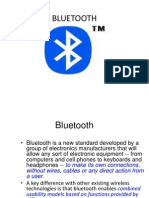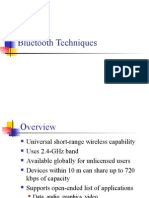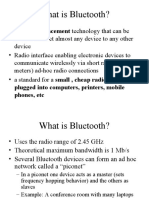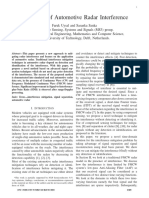0% found this document useful (0 votes)
8 views29 pagesUniversity Institute of Engineering Department of Computer Science & Engineering
The document provides an overview of Bluetooth technology, including its core specifications, protocols, and applications in wireless communication. It discusses the Bluetooth architecture, data rates, security features, and the importance of low power consumption for mobile devices. Additionally, it covers the testing and certification processes for Bluetooth devices and the various protocols that facilitate communication between devices.
Uploaded by
fevan74811Copyright
© © All Rights Reserved
We take content rights seriously. If you suspect this is your content, claim it here.
Available Formats
Download as PPT, PDF, TXT or read online on Scribd
0% found this document useful (0 votes)
8 views29 pagesUniversity Institute of Engineering Department of Computer Science & Engineering
The document provides an overview of Bluetooth technology, including its core specifications, protocols, and applications in wireless communication. It discusses the Bluetooth architecture, data rates, security features, and the importance of low power consumption for mobile devices. Additionally, it covers the testing and certification processes for Bluetooth devices and the various protocols that facilitate communication between devices.
Uploaded by
fevan74811Copyright
© © All Rights Reserved
We take content rights seriously. If you suspect this is your content, claim it here.
Available Formats
Download as PPT, PDF, TXT or read online on Scribd
/ 29



















































































